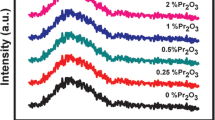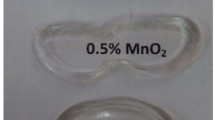Abstract
Five fluoro-phosphate (FP) glasses of different compositions, 49.5P2O5–10AlF3–10BaF2–10SrF2–10PbO–10M (M = Li2O, Na2O, K2O, ZnO, and Bi2O3), doped with 0.5 mol% praseodymium were prepared by melt quenching technique. For these glass matrices, structural, thermal, dielectric, electrical, and optical properties have been studied. The structures are characterized by XRD, Fourier transform infrared, Raman spectroscopy, and solid-state 31P and 27Al magic angle spinning nuclear magnetic resonance techniques. The chemical and electronic states of these glass materials are characterized by X-ray photoelectron spectroscopy. The thermal stability for the host glass matrix is estimated from differential scanning calorimetry technique. From the impedance spectroscopy, various parameters, viz. electrical conductivity, dielectric constant (ε′), and dielectric losses (tan δ), at various frequencies and temperatures have been measured. X-ray absorption near-edge spectroscopy was used to study the electronic structure of praseodymium in the host glass matrices. By analyzing the absorption spectra with Judd–Ofelt theory, three intensity parameters (Ω λ , λ = 2, 4, 6) are obtained. In turn, these parameters are used to calculate radiative properties such as emission probabilities (A R), radiative lifetimes (τ R), and integrated absorption cross sections (Σ) of different Pr3+ transitions. Luminescence parameters such as stimulated emission cross sections (σ p) and branching ratios (β exp) have been studied through photoluminescence spectra. Further, decay time constants are estimated from the decay profiles of Pr3+-doped different FP glasses.














Similar content being viewed by others
References
Som T, Karmakar B (2011) Nephelauxetic effect of low phonon antimony oxide glass in absorption and photoluminescence of rare-earth ions. Spectrochim Acta A 79:1766–1782
Czaja M, Bodył S, Gabryś-Pisarska J, Mazurak Z (2009) Applications of Judd–Ofelt theory to praseodymium and samarium ions in phosphate glass. Opt Mater 31:1898–1901
Choi JH, Margaryan A, Margaryan A, Shi FG (2005) Judd–Ofelt analysis of spectroscopic properties of Nd3+ -doped novel fluorophosphate glass. J Lumin 114:167–177
Belke´bir A, Rocha J, Esculcas AP, Berthet P, Gilbert B, Gabelica Z, Llabres G, Wijzen F, Rulmont A (1999) Structural characterization of glassy phases in the system Na2O–Al2O3–P2O5 by MAS and solution NMR, EXAFS and vibrational spectroscopy. Spectrochim Acta A 55:1323–1336
Zhang YY, Chen BJ, Pun EYB, Lin H (2009) Optical radiative parameters and 1:3 μm emission anticipation of Pr3+ in two kinds of bismuth-containing oxide glasses with lower phonon energies. Physica B 404:1132–1136
Zhang F, Bi Z, Huang A, Xiao Z (2015) Luminescence and Judd–Ofelt analysis of the Pr3+ doped fluorotellurite glass. J Lumin 160:85–89
Anjaiah J, Laxmikanth C, Veeraiah N, Kistaiah P (2015) Luminescence properties of Pr3+ doped Li2O–MO–B2O3 glasses. J Lumin 161:147–153
Gwizdala B, Reben M, Cisowski J, Lisiecki R, Romanowski WR, Jarzabek B, Mazurak Z, Nosidlak N, Grelowska I (2015) The influence of Pr3+ content on luminescence and optical behavior of TeO2–WO3–PbO–Lu2O3 glass. Opt Mater 31:1167–1172
Schwarz J, Tichá H, Tichý L, Mertens R (2004) physical properties of Pbo-Zno-P2O5 glasses I. Infrared and raman spectra. J Optoelectron Adv Mater 6:737–746
Zhang L, Sun H, Xu S, Zhang J, Hu L (2005) Special effects of YbF3+ on the structural changes for fluorophosphate glass. Physica B 367:1–5
Marzouk MA, ElBatal FH, Abdelghany AM (2013) Ultraviolet and infrared absorption spectra of Cr2O3 doped—Sodium metaphosphate, lead metaphosphate and zinc metaphosphate glasses and effects of gamma irradiation: a comparative study. Spectrochim Acta A 114:658–667
Li HW, Man SQ (2009) Optical properties of Er3+ in MoO3–Bi2O3–TeO2 glasses. Opt Commun 282:1579–1583
Hsu SM, Wu JJ, Yung SW, Chin TS, Zhang T, Lee YM, Chu CM, Ding JY (2012) Evaluation of chemical durability, thermal properties and structure characteristics of Nb–Sr-phosphate glasses by Raman and NMR spectroscopy. J Non-Cryst Solids 358:14–19
Poirier G, Messaddeq Y, Ribeiro SJ, Poulain M (2005) Structural study of tungstate fluorophosphate glasses by Raman and X-ray absorption spectroscopy. J Solid State Chem 178:1533–1538
Ivascua C, Gabor AT, Cozar O, Daraban L, Ardelean I (2011) FT-IR, Raman and thermoluminescence investigation of P2O5–BaO–Li2O glass system. J Mol Struct 993:249–253
Sahar MR, Wahab A, Hussein MA, Hussin R (2007) Structural characteristic of Na2-P2O5-GeO2 glass systems. J Non-Cryst Solids 353:1134–1140
Kirkpatrick RJ, Brow RK (1995) Nuclear magnetic resonance investigation of the structures of phosphate and phosphate-containing glasses: a review. Solid State Nucl Mag 5:9–21
Weng CZ, Chen JH, Shih PY (2009) Effect of dehydroxylation on the structure and properties of ZnCl2–ZnO–P2O5 glasses. Mater Chem Phys 115:628–631
Shih PY, Ding JY, Lee SY (2003) 31P MAS-NMR and FTIR analyses on the structure of CuO-containing sodium poly- and meta-phosphate glasses. Mater Chem Phys 80:391–396
Qiua D, Guerry P, Ahmed I, Pickupa DM, Cartaa D, Knowles JC, Smithb ME, Newport RJ (2008) A high-energy X-ray diffraction, 31P and 11B solid-state NMR study of the structure of aged sodium borophosphate glasses. Mater Chem Phys 111:455–462
Wiench JW, Tischendorf B, Otaigbe JU, Pruski M (2002) Structure of polyphosphate glasses studied by two dimensional solid and liquid state NMR. J Mol Struct 602–603:145–157
Hsu SM, Yung SW, Brow RK, Hsu WL, Lu CC, Wu FB, Ching SH (2010) Effect of silver concentration on the silver-activated phosphate glass. Mater Chem Phys 123:172–176
Tiwari B, Pandey M, Sudarsan V, Deb SK, Kothiyal GP (2009) Study of structural modification of sodium aluminophosphate glasses with TiO2 addition through Raman and NMR spectroscopy. Physica B 404:47–51
Gongyi G (1998) Structural study of a lead–barium–aluminum phosphate glass by MAS-NMR spectroscopy. Solid State Nucl Mag 13:119–122
Nagpure IM, Pitale SS, Coetsee E, Ntwaeaborwa OM, Terblans JJ, Swart HC (2012) Lattice site dependent cathodoluminescence behavior and surface chemical changes in a Sr5(PO4)3F host. Physica B 407:1505–1508
Majjane A, Chahine A, Et-tabirou M, Echchahed B, Do Trong-On, Mc Breen P (2014) X-ray photoelectron spectroscopy (XPS) and FTIR studies of vanadium barium phosphate glasses. Mater Chem Phys 143:779–787
Tshabalala MA, Dejene FB, Pitale SS, Swart HC, Ntwaeaborwa OM (2014) Generation of white-light from Dy3+ doped Sr2SiO4 phosphor. Physica B 439:126–129
Braunger ML, Escanhoela JA Jr, Fier I, Walmsley L, Ziemath EC (2012) Electrical conductivity of silicate glasses with tetravalent cations substituting Si. J Non-Cryst Solids 358:2855–2861
Ramteke DD, Gedam RS (2014) Study of Li2O–B2O3–Dy2O3 glasses by impedance spectroscopy. Solid State Ion 258:82–87
Sdiri N, Elhouichet H, Dhaou H, Mokhtar F (2014) Effects of the substitution of P2O5 by B2O3 on the structure and dielectric properties in (90−x) P2O5–xB2O3–10Fe2O3 glasses. Spectrochim Acta A 117:309–314
Sambasiva Rao K, Srinivasa Reddy M, Ravi Kumar V, Veeraiah N (2008) Dielectric, magnetic and spectroscopic properties of Li2O–WO3–P2O5 glass system with Ag2O as additive. Mater Chem Phys 111:283–292
Balaji Rao R, Gerhardt RA (2008) Effect of alkaline earth modifier ion on the optical, magnetic and electrical properties of lithium nickel borate glasses. Mater Chem Phys 112:186–197
Milankovi AM, Sklepi K, Blazanovi H, Mosner P, Vorokhta M, Koudelka L (2013) Influence of germanium oxide addition on the electrical properties of Li2O-B2O3-P2O5 glasses. J Power Sour 242:91–98
Ahmad MM, Yousef ES, Moustafa ES (2006) Dielectric properties of the ternary TeO2/Nb2O5/ZnO glasses. Physica B 371:74–80
Sujatha B, Viswanatha B, Chethana BK, Nagabhushana H, Reddy CN (2016) Electrical conductivity and dielectric relaxation studies on microwave synthesized Na2SO4·NaPO3·MoO3 glasses. Ionics 22:563–571
Hormesa J, Pantelouris M, Balazs GB, Rambabu B (2000) X-ray absorption near edge structure (XANES) measurements of ceria-based solid electrolytes. Solid State Ion 136–137:945–954
Kiebach WR, Chatzichristodoulou C, Werchmeister RML, Hagen A (2012) Determination of redox-active centers in praseodymium doped ceria by in situ-XANES spectroscopy. Chem Phys Lett 537:80–83
Pal I, Agarwal A, Sanghi S, Aggarwal MP (2011) Structural, absorption and fluorescence spectral analysis of Pr3+ ions doped zinc bismuth borate glasses. J Alloys Compd 509:7625–7631
Judd BR (1962) Optical absorption intensities of rare-earth ions. Phys Rev 127:750–761
Ofelt GS (1962) Intensities of crystal spectra of rare-earth ions. J Chem Phys 37:511–520
Manzani D, Paboeuf D, Ribeiro SJL, Goldner P, Bretenaker F (2013) Orange emission in Pr3+-doped fluoroindate glasses. Opt Mater 35:383–386
Goldner P, Auzel F (1996) Application of standard and modified Judd-Ofelt theories to a praseodymium doped fluorozirconate glass. J Appl Phys 79:7972
Srinivasa Rao L, Reddy MS, Reddy MVR, Veeraiah N (2008) Spectroscopic features of Pr3+, Nd3+, Sm3+ and Er3+ ions in Li2O–MO (Nb2O5, MoO3 and WO3)–B2O3 glass systems. Physica B 403:2542–2556
Srivastava P, Rai SB, Rai DK (2004) Effect of lead oxide on optical properties of Pr3+ doped some borate based glasses. J Alloys Compd 368:1–7
Metha V, Aka G, Dawar AL, Mansingh A (1999) Optical properties and spectroscopic parameters of Nd3+ doped phosphate and borate glasses. Opt Mater 12:53–63
Quimby RS, Miniscalco WJ (1994) Modified Judd–Ofelt technique and application to optical transitions in Pr3+ doped glass. J Appl Phys 75:613
Seeber W, Downing EA, Hesselink L, Fejer MM, Ehrt D (1995) Pr3+-doped fluoride glasses. J Non-Cryst Solids 189:218–226
Henry ND, Adam JL, Jacquier B, Linares C (1996) Photoluminescence of new fluorophosphate glasses containing a high concentration of terbium (III) ions. Opt Mater 5:197–207
Sourkova P, Frumarova B, Fruma M, Nemec P, Kincl M, Nazabal V, Moizan V, Doualan JL, Moncorge R (2009) Spectroscopy of infrared transitions of Pr3+ ions in Ga–Ge–Sb–Se glasses. J Lumin 129:1148–1153
Klimesz B, Dominiak-Dzik G, Solarz P, Żelechower M, Romanowski WR (2005) Optical study of GeO2–PbO–PbF2 oxyfluoride glass singly doped with Pr3+, Nd3+, Sm3+ and Eu3+. J Alloys Compd 403:76–85
Voda M, Balda R, Saleh MA, Ocáriz ISD, Cano M, Lobera G, Macho E, Fernández J (2001) Optical properties of Pr -doped lithium tetraborate glasses. J Alloys Compd 12:250–254
Mitra S, Jana S (2015) Intense orange emission in Pr3+ doped lead phosphate glass. J Phys Chem Solids 85:245–253
Man SQ, Pun EYB, Chung PS (1999) Tellurite glasses for 1.3 μm optical amplifiers. Opt Commun 168:369–373
Jamalaiah BC, Suresh Kumar J, Babu AM, Rama Moorthy L, Jang K, Lee HS, Jayasimhadri M, Jeong JH, Choi H (2009) Optical absorption, fluorescence and decay properties of Pr3+-doped PbO–H3BO3–TiO2–AlF3 glasses. J Lumin 129:1023–1028
Dzika GD, Romanowski WR, Pisarska J, Pisarski WA (2007) Spectral properties and dynamics of luminescent states of Pr3+ and Tm3+ in lead borate glasses modified by PbF2. J Lumin 122–123:62–65
Vijaya Kumar MV, Rama Gopal K, Reddy RR, Reddy GVL, Hussain NS, Jamalaiah BC (2013) Application of modified Judd-Ofelt theory and the evaluation of radiative properties of Pr3+-doped lead telluroborate glasses for laser applications. J Non-Cryst Solids 364:20–27
Acknowledgements
One of the authors S. Babu would like to thank University Grants Commission (UGC), New Delhi for the sanction of Senior Research Fellowship (SRF) under Research Fellowship in Sciences for Meritorious students (RFSMS) scheme. The authors are thankful to Dr. S.N. Jha, Scientific officer (SOH), A&MPD, BARC, Mumbai for providing EXAFS measurements. The support of Dr. C. Nayak, Scientific officer (SOD), A&MPD, BARC, Mumbai to analyze the data is gratefully acknowledged.
Author information
Authors and Affiliations
Corresponding author
Rights and permissions
About this article
Cite this article
Babu, S., Rajput, P. & Ratnakaram, Y.C. Compositional-dependent properties of Pr3+-doped multicomponent fluoro-phosphate glasses for visible applications: a photoluminescence study. J Mater Sci 51, 8037–8054 (2016). https://doi.org/10.1007/s10853-016-0073-7
Received:
Accepted:
Published:
Issue Date:
DOI: https://doi.org/10.1007/s10853-016-0073-7




